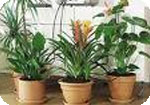| Tuesday, 13 May 2025 Home • About Us • Contact Us |
|
|
|
You are here:
House plants are used to brighten up a room and help to create a relaxing atmosphere, but they can also bring real health benefits.
Common house plants have found to purify indoor air, removing toxic air emissions like ammonia, formaldehyde, carbon monoxide, benzene, xylene and trichloroethytene. Studies have also shown that houseplants can reduce cold-related illnesses. A NASA study found that common house plants could improve indoor air quality. They reported that houseplants were able to remove up to 87 percent of air toxins in 24 hours. The report can be viewed here. Some of the results from the study:
How Plants Purify the Air Plant leaves can absorb certain organic chemicals and destroy these chemicals by a process called "metabolic breakdown." This was proven by a group of German scientists who looked at the absorption of formaldehyde and its metabolic destruction inside a spider plant (Chlorophytumn comosum). The formaldehyde was metabolized and converted into tissue products such as organic acids, sugars and amino acids. This information is published in the Plant Physiology Journal. [Giese M Detoxification of formaldehyde by the spider plant (Chlorophytum comosum). Plant Physiology, 1994, 104: 1301-1309]. When plants take in water vapor from their leaves, they pull air down around their roots, supplying their root microbes with oxygen, as well as other substances in the room air, such as toxic chemicals, and use these as a source of food and energy. Plants Help Control Indoor Humidity According a study carried out at the University of Agriculture in Norway, "Indoor plants can reduce fatigue, coughs, sore throats and other cold related illnesses by more than 30%", partially by increasing humidity levels and decreasing dust. Interior plants actually stabilize the humidity in your house by releasing moisture according to the existing levels of humidity in the air. [Dr Tove Fjeld, University of Agriculture, Norway 1995] Some Beneficial Houseplants Below are some of the chemicals found in the modern home and the best plants for removing these chemicals, in order of effectiveness according to the NASA study. Note: The common names are used for these plants, but as these can vary for different countries, the botanical names are also provided below. This is used in the construction of buildings in the form of urea-formaldehyde foam insulation (UFFI) and is also present in considerable quantities in wood used often in fitted or flat-pack furniture (e.g. kitchen cupboards and counters, bedroom wardrobes/closets). Other sources of formaldehyde include household cleaning products, fire retardants in soft furnishings, carpet backings. Formaldehyde irritates the mucous membranes of the eyes, nose, throat and respiratory system and is known to exacerbate asthma and trigger attacks. Best formaldehyde-removing plants: bamboo palm, dracaena 'Janet Craig', mother-in-law's tongue, dracaena marginata, peace lily, green spider plant, and golden pathos. Benzene Found in considerable amounts in tobacco smoke, commonly used as a solvent, and found in many common items such as paints, inks, oils, plastics, rubber, household cleaning products and petrol/gasoline. Chronic exposure to even relatively low levels of benzene is associated with headaches, loss of appetite, drowsiness, nervousness, psychological disturbances and diseases of the blood system, including anemia and bone marrow diseases. Best benzene-removing plants: gerbera daisy, pot mum, peace lily, bamboo palm, dracaena warneckei, English ivy and mother-in-law's tongue. Trichloroethylene A widely used industrial solvent that is often found in printing inks, paints, lacquers, varnishes and adhesives. Trichloroethylene is a central nervous system depressant and can cause headache, dizziness, and confusion. It is also known to cause liver and kidney problems with prolonged exposure and is now known to be cancer causing. Best trichloroethylene-removing plants: gerbera daisy, dracaena marginata, peace lily (spathiphyllum), dracaena 'Janet Craig' and bamboo palm. Carbon Monoxide This highly toxic gas is mainly produced from sources of combustion such as open fires, gas stoves, central heating boilers etc. All gas appliances in the home should be routinely checked for carbon monoxide leakage. Low level exposure causes dizziness and headaches while more acute exposure can lead to death since it prevents the delivery of oxygen to the body's cells. Best carbon monoxide-removing plants: bamboo palm, spider plant, golden pathos, dracaena 'Janet Craig'. dracaena marginata, snake plant, peace lily, chrysanthemum, English ivy and heartleaf philodendron. Botanical Names
The houseplants were found to be more effective at removing chemicals from the air when they were in optimal conditions for their health and growth. So remember to look after your houseplants, water them and keep them healthy, and they will keep you healthy.
Link to this article: Show: HTML Link • Full Link • Short Link
Related Articles: Add a Comment You must be registered and logged in to comment. |
|
 |
 | |
|
|

 "Low-light-requiring
"Low-light-requiring 






